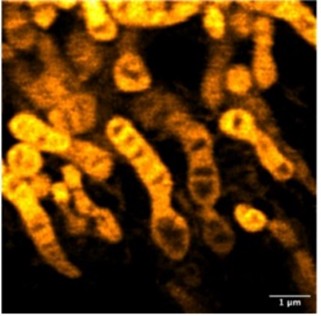Advantages
- Localizes in the inner mitochondrial membrane.
- Has large stokes shift.
- Can be highly functionalized by introducing functional groups (for example, controlling localization).
- Has a high fluorescence quantum yield of 60% in water, excellent cell membrane permeability, and can be stained at a low concentration (50nM).
Current Stage and Key Data
Partnering Model
- We are currently seeking a licensing partner for this fluorescent dye reagent.
- Feasibility studies can be conducted by concluding a CDA or MTA.
Background and Technology
Mitochondria are organelles present in all eukaryotes and are bounded by two membranes, an outer membrane and an inner membrane, which are folded into folds called cristae, where ATP synthesis occurs via oxidative phosphorylation.
Mitochondrial dysfunction is deeply related to many diseases such as neurodegenerative diseases, cancer, and diabetes, and in recent years, many research examples have been reported on mitochondrial function and aging.
Mitochondrial fluorescence imaging is a technique that can track mitochondrial dynamics in cells in real time, and various mitochondrial fluorescent labeling agents have been developed. Among them, many are linked to lipid-soluble cationic groups such as triphenyl-phosphonium (TPP), but in addition to their large molecular weight, their functional expandability is also limited. We have developed a fluorescent dye that solves these issues and confirmed its selective localization to the mitochondrial inner membrane. In the future, we plan to advance its functionality by improving its light resistance and localization control.
Principal Investigator
Shigehiro Yamaguchi, Prof. (Institute of Transformative Bio-Molecules(ITbM), Nagoya University, Tokai National Higher Education and Research System)
Patents
Pending
Project No.BK-04940



